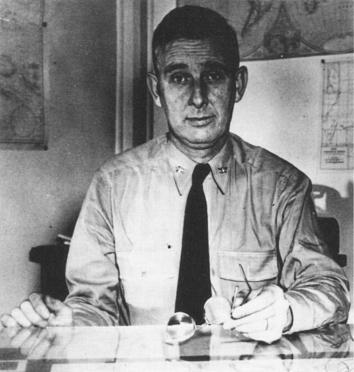Did the Us Use Code Cracking Again After Craking Japans Codes in Ww2
How Did the U.S. Break Japanese Armed forces Codes Before the Battle of Midway?
This question originally appeared on Quora.
Respond by Andrew Warinner, code monkey, expat, utility infielder:

Courtesy of U.S. Naval Historical Eye/Wikimedia/Artistic Commons
The U.South. had an excellent track record confronting Japanese codes and ciphers before World War Two, and this experience, combined with a variety of other sources of intelligence, helped the U.S.—primarily the radio interception station and decryption center Station HYPO run past Capt. Joseph Rochefort at Pearl Harbor, Hawaii—deduce that an attack on Midway was in the offing.
Japanese naval codes were unlike High german codes in World State of war 2. They were primarily "book" ciphers, while German codes used mechanical encipherment—the famous Enigma and Lorenz machines.
Book ciphers work similar this: The sender composes his bulletin and then consults the code book. Common words and phrases are replaced with a group of numbers and letters, and any remaining text is encoded character by character. The result is transmitted. The receiver then looks up each group in the corresponding lawmaking book and reassembles the message. An additional level of security can be added by enciphering the code groups themselves; this is called superenciphering.
Loftier-grade Japanese naval codes since the 1920s had relied on code books and superencipherment to protect their communications, and the U.S., Great Britain, Australia, and Holland all had had considerable success against them. The Purple Japanese navy did regularly alter their lawmaking books and the superencipherment technique, but the supherencipherment was more often than not weak and easily broken (Japanese characters were encoded equally romaji for manual, and this made them vulnerable to standard cryptological attacks such equally frequency analysis). The code books themselves were as well not radically changed (words and letters were organized alphabetically, and sections of code groups were incremented consecutively).
The principal Japanese naval code, the Navy General Operational Code, dubbed JN25 past the U.S., had a lawmaking volume of 90,000 words and phrases. Even when the superencipherment was stripped to reveal the lawmaking groups (9 character combinations in the instance of JN25), the meaning of each lawmaking grouping had to be inferred.
Deducing the contents of the JN25 code book was essentially an exercise in puzzle-solving. The meaning of particular code group could be inference past context or by cross-referencing its utilise in other letters. Codebreakers at Station HYPO were known for their prodigious memories, but they also fabricated extensive use of IBM punch-bill of fare sorting machines to find messages using specific code groups. The end result was a huge menu catalog representing the inferences and deductions of code groups of the JN25 code book.
So in early 1942 when the U.S. began detecting signs of an impending set on, the target was encoded as "AF." Locations in the JN25 code book were represented past a code group, and AF was not definitively known by the U.South. Other intelligence methods such as traffic assay pointed to a target in the Central Pacific, simply other U.S. naval intelligence organizations, particularly OP-20-G in Washington, D.C., disagreed well-nigh the location and timing of the impending attack.
And then the codebreakers at Station HYPO devised an ingenious experiment to confirm the identity of AF. Pearl Harbor and Midway Isle were continued by an underwater cable that was invulnerable to Japanese interception. Station HYPO sent orders to Midway by cable to broadcast a radio message that the island's desalinization plant had broken downward. The radio bulletin was circulate without encryption to ensure that Nihon could read it if information technology was intercepted.
The radio message was duly intercepted by Japan and reported by a message encoded in JN25 stating that AF'south desalinization plant was out of club. That message was intercepted by Station HYPO. AF was thus confirmed as Midway.
There remained the question of the timing of the set on. Station HYPO concluded that the attack would come up in late May to early June 1942, while OP-xx-Thousand said late June. Station HYPO won out once more because they had succeeded in bang-up JN25'due south date encryption and OP-20-G had non.
Station HYPO's intelligence persuaded Chester Nimitz, commander of the U.S. Pacific Armada, to take chances the three remaining U.S. carriers in the Pacific in an try to deadfall the Japanese attack on Midway. While Midway was a stunning victory for the U.S.—sinking four Japanese carriers for the loss of 1 U.Southward. carrier—that was enabled by intelligence and broke the uninterrupted cord of defeats and draws the Imperial Japanese navy had inflicted on the U.Southward. Navy, much hard fighting remained and more stinging defeats awaited the U.S. in the Pacific.
The bureaucratic feuding between Station HYPO and OP-20-Chiliad continued for the residuum of the war. Rochefort became a victim of the infighting; he was never promoted across helm, never received the ocean control he wanted, and received no decoration or award for his invaluable piece of work at Station HYPO during his lifetime.
More questions on Military machine History and Wars:
- Why did American soldiers commit so many atrocities in the Vietnam War, but non in World War Ii?
- If every single country got into a state of war with no alliances, who would win and why?
- What are the about important lessons of history?
Source: https://slate.com/human-interest/2013/11/u-s-in-world-war-ii-how-the-navy-broke-japanese-codes-before-midway.html
Enregistrer un commentaire for "Did the Us Use Code Cracking Again After Craking Japans Codes in Ww2"